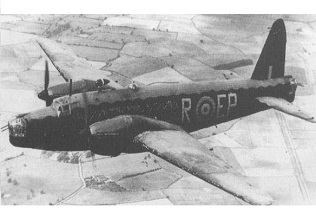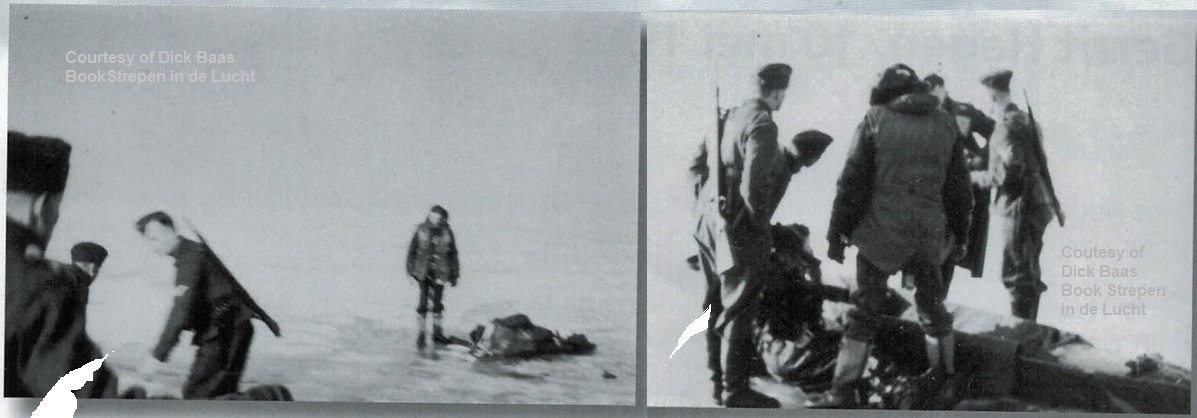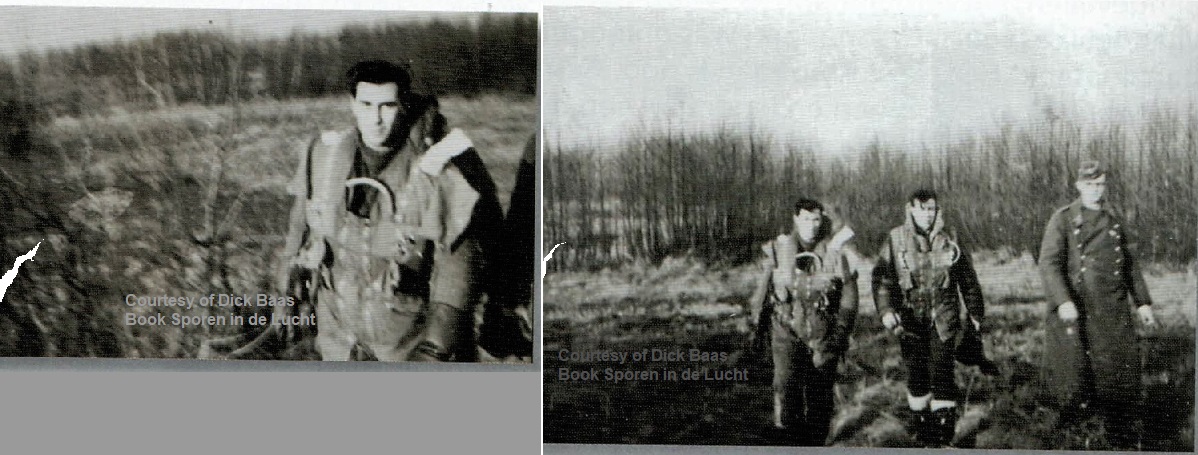| Date: 1941 Feb 10/11 | A/C Type: Wellington IC | SN: T2702 | Code: LS-H | A/C Nickname: |  |
|||||
| File: 160 | Airforce: RAF | Sqn/Unit: 15 Sqn | Mission/Raid: Hannover | |||||||
| 1 | Pilot | Sgt. William (Bill) R. Garrioch | 9 | |||||||
| 2 | CP/Obs. | Sgt. Willam H. Jordan | 10 | |||||||
| 3 | Nav | Sgt. Robert F. Beioley | 11 | |||||||
| 4 | W/opp-AG | Sgt. Hardie G. Hedge (New Zealand) | 12 | |||||||
| 5 | Front gunner | Sgt. Glyndwr Reardon KIA, buried Jonkerbos. | 13 | |||||||
| 6 | Rear gunner | Sgt. John Hall WIA | 14 | |||||||
| 7 | 15 | |||||||||
| 8 | 16 | |||||||||
Shot down by a German nightfighter and bellylanded on thick ice, Lake IJsselmeer (Old Zuyder Sea), 15 km west of Elburg. Sgt. Reardon was dead and left in the front turret. The survivors walked 12 hours on the ice before they reached land (became POW). |
||||||||||
German nightfigther Hptm. Walter Ehle was patrolling his 'box' Hase at Harderwijk, waiting on high altitude for returning RAF bombers that had bombed Hannover. At 23:35h, 1000 meters below him in the moonlight and just above the clouds, he saw a Wellington passing under flying west. Ehle dropped down, opened fire and set the bomber on fire. Pilot Sgt. Bill Garrioch had no other option than bellyland on Lake IJsselmeer. The lake was frozen solid. When the aircraft came to a stop, the crew evacuated the aircraft with help of the light coming from the flames.
Front turret gunner Sgt. Glyndwr Reardon, 19 years old, did not came out. The front of the aircraft had gone a bit through the ice and his turret came under water. The others could not reach him. The attention was directed to wounded tail gunner Sgt. John Hall. He had fired on the German Me-110, that had hit him in the lower legs with 20mm shells. The four that could walk, Garrioch, Jordan, Beioley and Hegde, dragged Hall onto the ice next to the bomber. The fire went out and it became very dark and ice cold. A strong snowy eastern wind blew over the ice, making it feel like the North Pole. They decided to walk east against the wind, find land and hope for the best. Sgt. Hall was put on a parachute that was towed as a slegde. Two days later, the abandoned Wellington was still laying on the ice, out of view some 15km from shore. The Germans came to know and made a visit and took photos, only recently discovered (below).

ABOVE IMAGE. A drawing based on the German photo 13 February 1941. Showing the T2702 of 15 Sqn (LS-H) as the Germans found it on the frozen lake. And the wounded Sgt. Hall on the parachute, as he was dragged to Elburg by his crew the day before. A week later the Wellington broke through the ice and landed on the lake bottom, only 3 meters deep. The frozen body of Sgt. Glyndwr Reardon was at that time still inside the front turret. Six and 26 years later (in 1947 and 1967) remains of him were found.
BELOW PHOTO: the frozen lake in February a few years ago.

Prisoners
When reaching shore south of Elburg the next day, February 12, 1941 at 16:00 (after 16 hours and 15km), the survivors were spotted and taken prisoner by the Germans. All five underwent medical treatment in the special (bugged) ward for Allied airmen in the Wilhelmina Hospital in Amsterdam. Shortly after that, the stay in the German Stalag prison camps commenced. Sgt. Hall was operated in the famous Obermansfeld Hospital near Frankfurt in Germany where his shank was amputated. Amazingly, in 2009 six photos came from Germany showing the arrest when the five survivors came to shore, see below.
These photos are a good example of photos nobody knew existed. They come from the private albums of former German soldiers.
BELOW: the Germans have spotted the British airmen on the ice and come towards them with a scavenged canoe.

BELOW. The wounded Sgt. Hall is carefully laid down in the canoe. A few days later his leg is partly amputated. It is a shame John Hall never saw these images.

BELOW: Pilot and navigator on the shoreline, accompanied by a German soldier.

The above photos show piloot Sgt. Bill Garrioch (left) and him with navigator Sgt. Robert Beioley (right) and the German.
1947 recovery
This part of the Lake was an intense used area for trawl fishing, an eel-rich section that was named "The Geldersman". The fishing continued during the war. In 1941, 1942, 1943, 1944 until February 1945, fisherman repeatedly lost nets on this underwater aircraft wreck. In the trawling and the proces of getting stuck nets free, the Wellington was gradually torn to pieces. Nevertheless, after the war the wrecksite was reported to the the Dutch authorities with request for clearance. This was done by the Dutch Navy in 1947 who sent a helmet diver and a crane. From a turret came remains of an unknown airman and buried as 'Known to God, An Airman, RAF' in CWGC Jonkerbos War Cemetery in Nijmegen on 26 june 1947, plot 8, row C,grave 3. In files was noted 'unknown airman from the rear turret of a salvaged Wellington aircraft, IJsselmeer'. The turret however must have been the (simular) front turret. Apparently identifcation by the RAF succeeded, because on 18 March 1952 the unknown status was changed to Sgt. Glyndwr Reardon. Shortly afterwards the grave stone was changed and Sgt. Reardon got a stone with his name.
The wreck recovered was reported by the Dutch Navy simply as "English aircraft wreck" and got number 91 on the recovery map. Some parts were not recovered by the diver as they were sunken in the mud and formed no obstruction. In these left parts, more remains of Sgt. Glyndwr Reardon were found 20 years later (1967) when the area was farmland.

1967 recovery
This section of the Lake became a polder named 'Oost Flevoland'. In 1957 it fell dry. Gradually over the years the former seabed was cultivated. More than 15 aircraft wrecks were encountered. Because Wellington T2702 was already recovered in 1947, it was not one of the 15 aircraft that were found in the new dry land. But in October 1967 farmer Mr. Aaldering discovered small aircraft parts in his land, on plots U-20 and U-21. He contacted the Dutch Air Force recovery team who were working at that time in the further D en E-sections, the last polder sections under construction. They went to Aalderding's farm and plot U-20/21. Cockpit parts of a Wellington came out of his field, remains of an airman emerged also. That same day, 11th of October 1967, the Dutch Airforce headquarters had received a letter from the UK. It was a letter from pilot Bill Garrioch, asking if there was any trace ever found of his bomber T2702 with his missing gunner. Apparently, he (and the Dutch Air Force recovery team) were still under the impression that the status for Sgt. Reardon was MIA. However, he was buried in Nijmegen. Status of the grave had changed from Unknown Airman to Sgt. Reardon only a few years before. A loose serial number plate of a Bristol Pegasus engine found in the field revealed the identity of the aircraft parts, which meant that the human remains had to be of Sgt. Reardon. We believe these remains were added to his Nijmegen grave in 1967. Jonkerbos War Cemetery file: https://www.zzairwar.nl/dossiers/960.html
Today a commemoration pole (P12) for T2702 stands at U-21, address Zeebiesweg no. 25, Biddinghuizen.

The 1979 documentary "Some of our airmen are no longer missing".
The above documentary was made in the new Flevo polder. A former section of the Old Zuyder Sea. A British film crew followed Dutch Air Force recovery officer Gerrit Zwanenburg (MBE) for some years, first take is from 1971, last from 1979. Seven aircraft and their crews are highlighted (two American, three RAF and two German). Sgt. Hall is returning to the crash location at 30:23 and 43:10.
03:10 - 13:15. Intro. Holland's airspace. Schiphol. The You-Tube link for the docu: https://www.youtube.com/watch?v=gTpAXE4WIJM
30:23 - 32:34. "The morning is freezing cold, just as it was in February 1941". In the second car is John Hall, Sgt. gunner in the rear of a Wellington bomber. Emergency landing on the Lake ice.
One KIA. The location where they stand is the Zeebiesweg-road no. 25, Biddinghuizen (No. 6) Wellington T2702, crew Sgt. W. Garrioch, RAF 15 Sqn. Night 10/11 February 1941.
43:10 - 43:45. Sgt. John Hall about MIA. Followed by Mr. Ron Emney (must be: Emeny). Sgt. R.T. Emeny shot down over France (evd) in Lancaster ND556, crew F/Sgt. Lissett, 3/4 May 1944.
Piloot Bill Garrioch had visited the crash site before. Farmer Aaldering gave him Wellington's T2702 steering wheel, found in the field.
Below photo: Tail gunner John Hall returning to the crash site (now land) in 1978.

Sources:
- website CWGC
- Website PATS on T2702: http://www.teunispats.nl/t943.htm With crew photos 1941. Thanks to Teunis Schuurman.
- crew interviews and letters 1965
- Flevoland archives.
- Dhr. Dick Baas, Nunspeet. Book Sporen in de Lucht
- Docu "Some of our Airmen are no longer missing".
© ZZairwar (Zuyder Zee Air War)